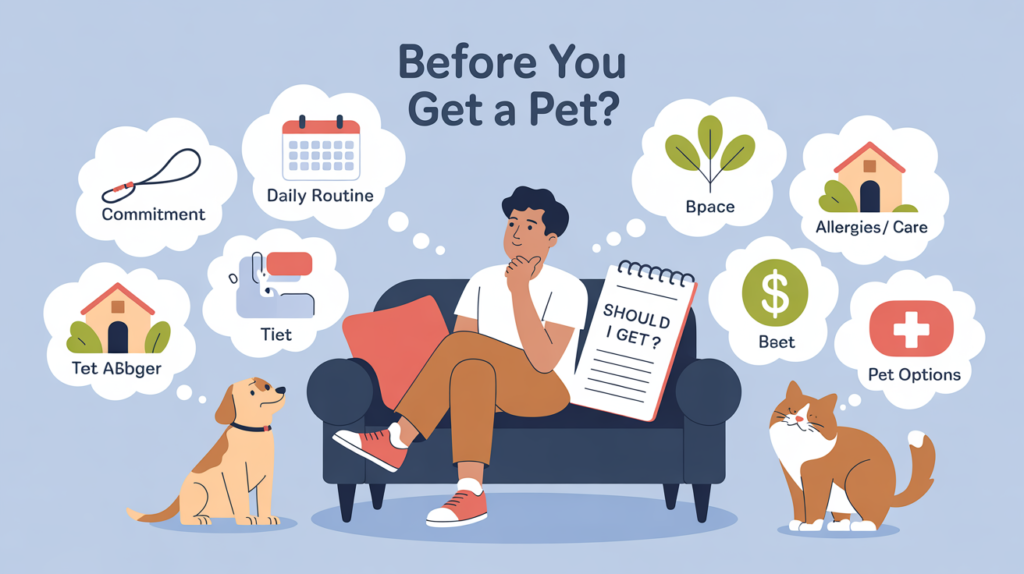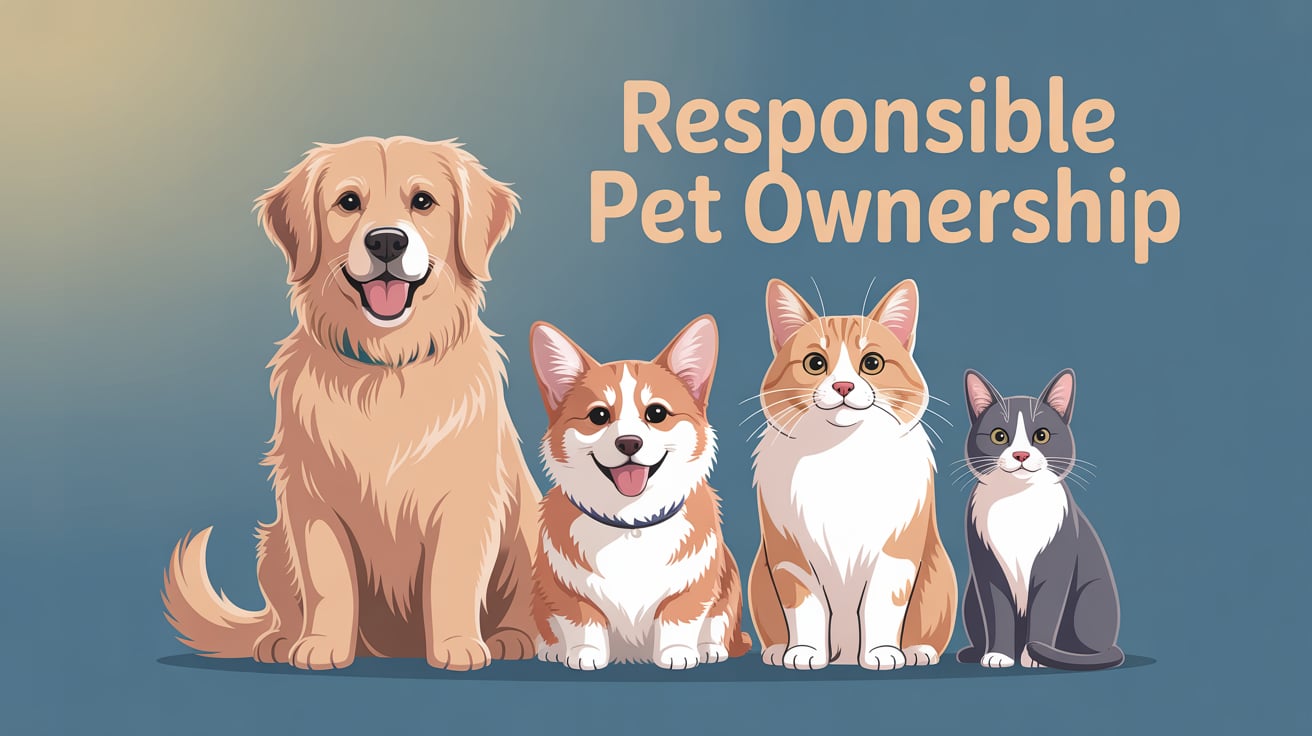7 Simple Steps to Responsible Pet Ownership/Parenting Today
Bringing a wagging tail or a purring friend into your home is an unparalleled joy. The excited greetings, the comforting presence, the endless entertainment – pets enrich our lives in countless ways.
But beneath the irresistible cuteness lies a profound truth: responsible pet ownership is far more than just providing food and cuddles. It’s a profound commitment, a lifelong lifestyle that requires careful planning, dedication, and an understanding of every facet of your companion’s life.
This isn’t a temporary hobby; it’s a promise to provide love, care, and support through every stage of their journey. Organizations like the AVMA (American Veterinary Medical Association) emphasize the immense responsibility and rewards of pet guardianship. Are you ready to embark on this incredible adventure?
This comprehensive pet ownership guide will walk you through everything you need to know: from crucial considerations before you welcome a pet, through the vital adjustment period during their arrival, and the essential routine care and support needed after they settle in.
📌 Key Takeaways of Guide to Responsible Pet Ownership
- • Ownership is a Lifelong Commitment: Bringing a pet home is a long-term responsibility that requires dedication to their emotional, physical, and financial needs through all life stages.
- • Plan Thoroughly Beforehand: Honestly assess your lifestyle, budget, and living situation to ensure compatibility and meet all care expectations.
- • Prioritize Health & Safety: Regular vet care, vaccinations, and considering pet insurance are vital for your pet’s well-being and your financial preparedness.
- • Positive Reinforcement Builds Trust: Training should be rooted in positivity, consistency, and understanding—not punishment.
- • Adapt and Learn Continuously: Be flexible with routines, handle behavior changes with patience, and seek professional help when needed.
Thinking of Getting a Pet? Ask These Questions First

The excitement of a new pet can be overwhelming, but pausing to ask critical questions beforehand ensures a harmonious match. This isn’t just about choosing; it’s about what to consider before getting a dog or cat to ensure their well-being and your peace of mind.
First, honestly assess your time availability and lifestyle compatibility. Do you have hours for walks, playtime, and training a high-energy dog breed, or is a more independent cat breed better suited to your schedule?
Think about your housing situation – is your landlord pet-friendly? Do you have a secure yard for a dog, or ample vertical space for an indoor cat? Don’t forget to consider allergies within the household. Read all about the Common Health Problems in Pets Every Owner Must Know.
Next, get real about budgeting for pet ownership costs. Beyond the initial adoption fee or purchase price, pets come with ongoing expenses. Factor in food, regular vet care (vaccinations, checkups), grooming, toys, and unexpected emergencies. A robust budget is key to preventing future stress.
Decide where your pet will come from. Are you considering adopting a rescue pet from a shelter like Petfinder or Adopt-a-Pet, or are you looking for a specific temperament from a reputable breeder? Each path has unique benefits. When considering choosing the right pet for your lifestyle, research different dog breeds and cat breeds.
Understand their typical energy level, grooming needs, and general care expectations. A Labrador needs more space and exercise than a Persian cat. The AVMA offers fantastic breed guides to help.
Remember, a successful pet partnership begins with informed decisions. Choosing wisely now lays the foundation for years of mutual joy. If you’re looking for specific needs, consider our guides on Low-maintenance cat breeds, Best small dog breeds, or Best dog breeds for first-time owners.
“Over 70% of U.S. households—an incredible 90.5 million homes—own a pet. Dogs top the chart with 69 million households, followed by 45.3 million cat-loving homes.
But true pet ownership goes beyond love — it means being ready financially, scheduling regular vet visits, ensuring safety, and meeting your pet’s needs for grooming, exercise, hygiene, and a balanced diet.”
What Should You Expect in the First 30 Days With a New Pet?
The first month with a new pet is a crucial adjustment period. It’s a time for trust-building, setting boundaries, and establishing a comfortable home routine. For first-time pet owner tips, consider this your essential checklist.
Preparing Their Safe Haven
Before they even walk through the door, prepare your home. Create a safe, welcoming space with a designated crate (for dogs), cozy bedding, appropriate pet toys, and food/water bowls. Ensure your home is thoroughly pet-proofed, removing any hazards.
This proactive crate setup provides a secure den, especially vital for what to do when you get a new puppy. You can learn more about Ultimate Pet Safety at Home: Protect Your Furry Friend.
Navigating the Initial Days
The first few days will be about gentle introductions. For puppy/kitten starter tips, focus on establishing a consistent feeding and potty schedule. Keep interactions calm and positive, allowing them to explore at their own pace.
Adult pets, especially adopting a rescue dog/cat, might need more time to decompress. Rescues may come with unknown histories, so patience is paramount. Provide a quiet, safe haven and let them initiate contact.
Introducing New Pets to the Household
When introducing new pets to existing animals, proceed slowly and cautiously. Use separate spaces initially, allowing them to acclimate to each other’s scents before supervised, brief visual introductions. Never force interactions.
For detailed strategies, see our guide on [How to introduce a new cat to a dog]. This initial phase sets the tone for your pet’s emotional security and future behavior shaping.
How Do You Choose the Right Vet, Insurance, and Healthcare Plan?
Long-term responsible pet ownership is inextricably linked to robust healthcare. Ensuring your pet’s well-being means prioritizing vet care from day one, throughout their entire life.
The Importance of Preventive Care
The cornerstone of good health is preventive vet care. This includes a regular schedule of vaccinations to protect against common diseases, annual checkups even when they seem healthy, and consistent dental care to prevent painful oral issues.
Regular visits to your vet aren’t just for emergencies; they’re vital for early detection of potential health problems, saving both stress and cost in the long run. You can also read more in details about Smart Preventative Pet Care That Saves Lives.
Choosing Your Veterinary Partner
Choosing the right vet is a personal decision. Look for a local vet clinic with a compassionate team, good reviews, and clear communication about treatment options. The relationship with your vet is a partnership in your pet’s health. For more guidance, explore How to choose a vet.
Understanding Pet Insurance
Understanding pet insurance is also critical for financial preparedness. Companies like Trupanion and Healthy Paws offer plans that can significantly offset the cost of unexpected illnesses or accidents. While it’s an additional monthly expense, the peace of mind can be invaluable.
Research the benefits of pet insurance carefully, weigh the pros, cons, and costs, and consider it a vital part of your overall budgeting for responsible pet ownership. It’s about protecting your furry family member without breaking the bank.
Can You Afford a Pet? Here’s What Budgeting Really Looks Like
Many new pet owners underestimate the true financial commitment involved. Pet ownership costs extend far beyond the initial adoption fee. Realistic budgeting for pet expenses is crucial for long-term care.
Initial vs. Ongoing Pet Costs
Initial One-Time Costs
Initial one-time costs typically include the adoption fee or purchase price, spaying/neutering (if not already done), initial vaccinations, a crate, leash, collar, bedding, bowls, and various pet toys. These can quickly add up, so factor them into your initial financial plan.
Ongoing Monthly/Annual Costs
More significant are the monthly/annual expenses. These routinely include quality dog food or cat food, regular vet visits, flea and tick prevention, heartworm medication, and potentially professional grooming. The average cost of owning a dog or cat varies widely by size, breed, and health needs, but it’s a substantial ongoing investment.
⚠️ Preparing for the Unexpected
Don’t forget unexpected expenses. Pet emergencies can be costly, ranging from accidental injuries to sudden illnesses. Factor in potential damage to property (especially with puppies!), boarding fees if you travel, and training classes. This is where pet insurance truly proves its worth, acting as a financial safety net.
📊 Tip: Create a Pet Expense Budget Planner
Creating a detailed Pet expense budget planner can help you visualize and manage these costs effectively. A well-prepared budget ensures you can provide the best possible quality of life for your beloved companion without financial strain.
Is Your Family Emotionally Ready to Bond with a Pet?
Building a strong bonding relationship with your pet and fostering good behavior starts with intention and understanding. This isn’t just about discipline; it’s about mutual respect and clear communication, especially for first-time pet owner tips.
Setting Boundaries and Routines
Establishing consistent boundaries and routines from the start is paramount. Regular feeding times, designated play periods, and consistent training sessions create predictability and security for your pet. For dogs, this means consistent walks on a leash and structured playtime. For cats, it means regular interaction and access to appropriate scratching surfaces.
The Power of Socialization
Socialization is incredibly important, particularly for kittens, puppies, and rescues. Expose young pets to a variety of safe sights, sounds, people, and other animals during their critical developmental periods. For rescue pets, this may involve gentle, controlled introductions to new stimuli to help them overcome past negative experiences.
Proper socialization aids in behavior shaping, leading to a confident, well-adjusted companion. Consider enrolling in training classes as a fun way to socialize and learn together.
Managing Anxiety and Ensuring Safety
It’s also vital to prepare for potential challenges. Understand coping strategies for pet anxiety (e.g., thunder phobia, separation distress). Have a plan for escape prevention by ensuring secure fences, using a properly fitted training collar or harness, and always having up-to-date safe ID tags.
If a pet escapes, knowing how to find a lost cat or dog involves quick action and community alerts. When it comes to discipline, always use positive reinforcement; never punishment. Rewarding good choices builds trust-building and cooperation. Explore our Pet training basics for a deeper dive into effective methods.
What Are the Most Common Mistakes New Pet Owners Regret?
Even with the best intentions, new pet owners can stumble. Awareness of first-time pet owner mistakes can prevent frustration, disappointment, and even early pet-owner regret. Learning from others’ missteps is a smart move.
Neglecting Socialization and Consistency
One common pitfall is skipping socialization. Neglecting to expose kittens or puppies to diverse sights, sounds, people, and other animals during their critical early months can lead to fearful or aggressive behavior later in life.
It’s not just playtime; it’s vital developmental exposure. Similarly, inconsistent training is another major issue. If rules vary between family members or from day to day, your pet will be confused. Clear, consistent commands and expectations are vital for effective behavior shaping and a well-behaved companion.
Overlooking Preparation and Preventive Care
Many people also fail to properly pet-proof the house. An un-proofed environment sets your pet up for destructive behaviors (like chewing furniture) and puts them at risk from toxic substances or electrical cords. A properly sized crate and designated safe spaces are crucial for dogs.
Finally, delaying vet care or skipping insurance can lead to preventable health issues and significant financial strain. Regular preventive health checkups and a solid pet insurance plan are cornerstones of responsible pet ownership. Neglecting these can result in costly emergencies and compromised quality of life for your pet.
If behavior issues escalate, neglecting to consult a behaviorist or professional trainer is a missed opportunity for effective intervention. Avoid these early missteps for a smoother journey. You can also read more in details about Smart Preventative Pet Care That Saves Lives.
How Do You Stay a Responsible Pet Owner for Life?
Responsible pet ownership isn’t a phase; it’s a long-term care commitment that evolves as your pet ages. Understanding and adapting to their changing needs is crucial for maintaining their quality of life.
Adapting to Aging Pets
As pets age, their needs shift. Aging pets may experience changes in mobility, senses (hearing, sight), and cognitive function. This requires lifestyle adaptations: softer beds, ramps, adjusted exercise routines, and potentially a special senior dog food or cat food.
Recognizing signs of discomfort or cognitive decline and seeking prompt vet care is paramount. Some owners even explore pet hospice options for compassionate end-of-life care.
Future Planning for Your Companion
Mental stimulation remains vital for senior pets, though it might take different forms like puzzle toys or gentle sniffing games. Maintaining their dignity and comfort in their later years is a profound responsibility.
Beyond daily care, responsible ownership extends to future planning. It involves considering rehoming ethics if unforeseen circumstances prevent you from caring for your pet (and exploring all alternatives first).
For many, it also means including pets in estate planning documents to ensure their continued care should anything happen to you. This forward-thinking approach truly embodies the spirit of responsible ownership.
FAQs: Quick Answers for Pet Ownership Success
Got quick questions? Here are some common queries to help you on your pet ownership guide journey.
How much does it cost to own a pet each year?
The average cost of owning a dog or cat varies widely by size, breed, and health, but typically ranges from $700-$2,000 annually, not including emergencies. Factor in food, vet care, grooming tools, and supplies.
What is responsible pet ownership?
Responsible pet ownership means fully committing to meeting your pet’s physical, emotional, social, and medical needs throughout their entire life. It includes providing proper nutrition, training, companionship, preventive veterinary care, and a safe living environment. Being a responsible pet owner also means understanding your pet’s unique needs and making lifestyle choices that prioritize their long-term well-being.
What are the responsibilities of a pet owner?
A pet owner’s responsibilities include:
- Providing consistent food, clean water, and shelter
- Ensuring regular vet visits, vaccinations, and grooming
- Training and socializing the pet humanely
- Meeting exercise and mental stimulation needs
- Keeping the pet safe, healthy, and loved
- Budgeting for both expected and emergency expenses
- Following local laws (ID tags, leash rules, spaying/neutering)
Responsible ownership is about daily care, commitment, and compassion.
How to be a more responsible pet owner?
To be a more responsible pet owner:
- Educate yourself on your pet’s breed or species needs
- Stick to a regular routine (feeding, exercise, vet care)
- Use positive reinforcement for training
- Monitor your pet’s behavior and health for changes
- Pet-proof your home to ensure safety
- Keep identification updated in case they get lost
- Plan for long-term care, even in emergencies
Small, consistent efforts lead to a happier, healthier pet and a stronger human-animal bond.
What is responsible pet ownership and animal welfare?
Responsible pet ownership and animal welfare go hand-in-hand. It means caring for your pet’s well-being while also recognizing your ethical duty to treat all animals with kindness and respect. It includes supporting humane practices, avoiding neglect or abuse, and choosing adoption, ethical breeders, or rescues. Promoting animal welfare also means being a voice for animals in need and making informed, compassionate decisions.
Is pet insurance worth it?
For many, yes. Pet insurance can provide significant financial relief for unexpected illnesses or accidents. Weigh the monthly premiums against potential emergency vet bills, and research different insurance providers like Trupanion or Healthy Paws.
What’s the best age to adopt a dog or cat?
Puppies and kittens are great for early socialization and training, usually adopted around 8-12 weeks. Adult rescues often come with some behavior history and may be house-trained, offering a more predictable personality. The “best” age depends on your lifestyle compatibility and experience.
How do I find a reputable breeder or rescue?
For rescues, look for organizations listed on platforms like Petfinder or Adopt-a-Pet with transparent adoption processes. For breeders, seek those focused on health and temperament, who allow visits and provide health clearances. Avoid puppy mills. The AVMA offers guidelines.
Can I have a pet with allergies?
It depends on the severity of allergies. Some dog breeds (e.g., Poodles, Portuguese Water Dogs) and cat breeds (e.g., Sphynx, Devon Rex) are considered more “hypoallergenic,” but no pet is truly allergen-free. Consult an allergist and spend time with specific breeds to test reactions. Pet allergy testing may also be an option.
What’s the best first pet for a family with kids?
Generally, well-socialized adult rescues with known temperaments, or specific dog breeds known for patience (e.g., Golden Retrievers, Labradors) and certain calmer cat breeds are often recommended. Consider the pet’s energy level and the children’s age and maturity.
Conclusion: The Pet Owner’s Promise
Owning a pet is truly a privilege, but it comes with a profound responsibility. It’s a lifelong journey filled with immense love, learning, and mutual growth. By understanding their needs, committing to their care, and embracing positive behavior shaping, you’re not just providing a home; you’re fulfilling a promise.
We hope this new pet guide has empowered you with the knowledge and resources to confidently embark on or continue your journey of responsible pet care. The bond you build through this dedication will be one of the most rewarding experiences of your life.
Resources:


One Comment